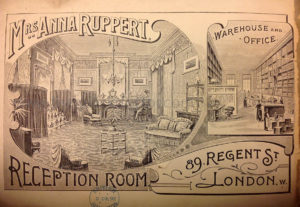 As we have seen before, nostrum-vendors’ talents were more suited to salesmanship than to poetry. This ad gets off to a tolerable start, but come verse 3 it goes downhill fast, and by the bit about the sheep it’s apparent that the copy-writer just wanted to get the wretched thing out the door and go home:
As we have seen before, nostrum-vendors’ talents were more suited to salesmanship than to poetry. This ad gets off to a tolerable start, but come verse 3 it goes downhill fast, and by the bit about the sheep it’s apparent that the copy-writer just wanted to get the wretched thing out the door and go home:
..
What hear we now from West to East
Counfounding man, befriending beast,
But Centaur Liniment?—
What is it cures our many pains,
And limbers up severest strains
But Centaur Liniment?—
That knocks Rheumatism out of gear,
Bids gout good-by without a tear?
Why! Centaur Liniment:
Causes the cripple to walk, the lame to leap,
Hearts to thank, instead of eyes to weep,—
Only, Centaur Liniment.
What renders reptiles tooth and sting of bees
Harmless as the bite of fleas,
Excepting Centaur Liniment;
Assuages the pangs of a broken breast,
Flows to lacteal fluid, gives nights of rest,
But Centaur Liniment;
When chilblains sting or hot steam scalds,
What is it soothes, for what can we call,
But Centaur Liniment.
When the car crushed old Tilden’s arm,
‘Twas saved from amputation by this charm
The Centaur Liniment;
And when Barnum’s lion, Uncle Ben,
Broke his leg in that dismal den,
He roared for Centaur Liniment.
Now as the poor horse, lame and sore,
With crippled knee limps to our door,
And begs for Centaur Liniment;
And the docile sheep on a thousand hills,
Die by the million—the screw worm kills,
(All saved by Centaur Liniment; )
We hear it shouted from West to East,
By speaking man and neighing beast,
“Pass on the Centaur Liniment!”
This remarkable article is for sale by all
Druggists in every village, parish and ham-
let, in America. We warrant it to cure.
J.B. Rose & Co, 58 Broadway, N. Y.
.
Source: The Marshal Statesman (Michigan) 4 Dec 1872
.
Centaur Liniment arrived on the scene in 1871, and in October the following year its adverts took the form of a purported news story about the massive outbreak of equine influenza that was sweeping Canada and the US. In Buffalo, NY, the adverts claimed, ‘there are not well horses enough to carry merchandise through the streets… there are probably 12,000 sick horses in New York and Brooklyn to-day.’
‘The Centaur Liniment seems to be the specific acting both upon the glands and joints, and superior to the turpentine, opodeldoc and capsicum. When the throat, belly and legs of the animal are early rubbed with this Liniment, and cloths saturated with it bound on the legs, the disease is checked and the animal soon recovers.’
Although patent remedy adverts are prone to exaggeration, the Centaur ads were not inflating the extent of the epizootic. Beginning in Toronto in early October 1872, the disease quickly spread to the US and down the eastern seaboard, getting all the way to Cuba within 90 days. The New York Times reported that on Oct 25 alone, the number of cases in the city increased by 60%. Very few horses remained unaffected.
The outbreak was disastrous for the economy, completely disabling transport networks. Tram, omnibus and stagecoach services came to a standstill, and fire wagons had to be pulled by the firemen. Even the railways could not function without wagons to receive the goods from the trains. Because of the virulence and near-universality of the disease, the epizootic at least burnt itself out quickly.
Treatment with Centaur Liniment was indeed usually followed by recovery – about 98% of affected horses got better anyway, with or without it.
According to Charles Oleson in Secret Nostrums and Systems of Medicine (10th Ed 1903) the animal liniment was made from oil of spearmint, oil of mustard, oil of amber, black oil, soap, caustic soda and water, though his recipes were intended to be ‘near enough’ rather than an exact copy of the formula.
The human version of the liniment was thicker in texture and a lighter colour, comprising oil of pennyroyal, oil of thyme, oil of turpentine, soap, caustic soda and water. The products were made by J B Rose and Co, later known as The Centaur Company, who also manufactured the famous Fletcher’s Castoria. The company’s US advertising campaigns were huge but, while the products did make it to the UK, the Liniment wasn’t promoted as much here – and we lucky Brits were spared the poetry.



That’s quite a literary effusion! It belongs in The Stuffed Owl – the anthology of bad Victorian poetry (I think it is out of print, which is a shame).
I just looked up The Stuffed Owl and there was apparently a new edition a few years ago. I’ve never read it – sounds funny!